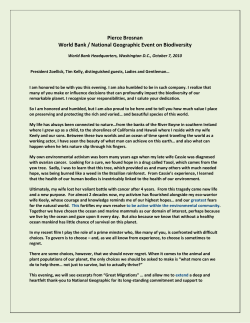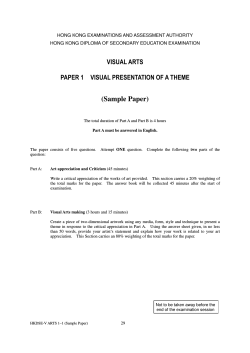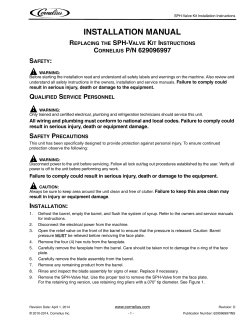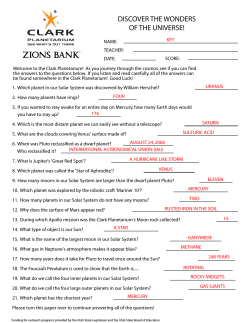
T How the Earth Was Made
History Classroom presents How the Earth Was Made Classroom Premiere: April 7-8 at 6am ET/PT Classroom Encore: June 9-10 at 6am ET/PT T he Earth’s 4.5-billion-year history is marked by extreme environments and tremendous catastrophes. Yet this changing world of fire, ice, raging seas, and toxic skies is the only known home for human life in our vast and distant universe. From the barren glaciers of Iceland and the breathtaking heights of the Matterhorn, to the rocky shores of Australia and the depths of the Hawaiian ocean, How the Earth Was Made takes an incredible journey around the globe. This 90-minute documentary begins nearly 5 billion years ago with the creation of the Earth and narrates the major changes in its traumatic, though miraculous, history. Insightful commentators, including historians and scientists, describe the unique challenges the human species may face in both the near and distant future. This program offers students powerful images and graphics to help them visualize how the Earth has transformed over time and how scientists predict the changes that may lie ahead. 18 The Idea Book for Educators History.com/classroom Montana, Glacier National Park Curriculum links Extended activities How the Earth Was Made fulfills several standards as outlined by the National Council for History Education including: (1) Human Interaction with the Environment; and (2) Cultural Diffusion and Innovation. It is appropriate for middle and high school students. It will connect with a variety of courses including Social Studies, Geography, Science and Technology, and Earth Sciences. 1. How the Earth Was Made narrates a fascinating timeline of the Earth’s history. In small groups, ask students to create projects on posterboard or in PowerPoint format, mapping out each important stage in this incredible process. In their presentations, ask students to describe: (1) when each significant event occurred, (2) what the Earth looked like, and (3) what forms of life existed during this era. On a shorter timeline students can include the major discoveries over the past 200 years that have helped unravel the mystery of the Earth’s incredible past. Ask students to share these projects with the larger class or group. Vocabulary Using the dictionary at www.merriamwebster.com, an Internet resource such as www.history.com, or an encyclopedia, students should define or explain the significance of the following terms: Cambrian explosion Pangaea plate tectonics deep time Paradoxides radioactive dating Fisher Canyon pillow lava thermodynamics volcanism Discussion questions 1. What did the Earth look like almost 5 billion years ago? What is the source of this extreme heat? 2. How did 21-year-old Arthur Holmes revolutionize our understanding of earth history? How does radiometric dating work? 3. Where do scientists believe most of the Earth’s water came from? 4. How did stromatalites change the planet? 5. How did fossils with intercontinental distribution lay the foundations for the discovery of plate tectonics? 6. What did the discovery of Burgess Shale quarry reveal? 7. What is significant about the Okie Fanokie swamp? What is a “modern analogue”? Do you agree with this description? 8. What incredible source of riches was created in the era of the dinosaurs? How is this precious rock produced? 9. What cataclysmic event occurred that wiped out nearly the entire ecosystem of the planet? What remarkable piece of evidence solved the mystery of this mass extinction? 10. How are glaciers formed? What would happen if global temperatures dropped just a few degrees? 11. What major climate challenge might we face in the future? What far greater problems could be caused by changes in plate tectonics? The Big Hole in Kimberly, South Africa. It’s a volcanic pipe where a kimberlite volcano came up which could then be mined for diamonds. Photo: Peter Chinn, Pioneer Productions. 2.The Earth is a constantly evolving planet. How the Earth Was Made describes the Earth’s highly volatile past, but also looks ahead at the significant changes we may expect in the future. Ask students to imagine that they are living living 100,1,000 or even 1 million years from now. In short essays of 2-3 pages, ask them to describe what the earth looks like, how the environment has changed, and what unique challenges face the human species. 3.How the Earth Was Made helps explain many difficult concepts about the origins of the planet and its changes over time. Ask students to translate this information to a younger audience by creating short picture books for younger readers. These picture books could be in PowerPoint, as written documents, on construction paper, or as storyboards on posterboard. They should be sure to include key concepts from this documentary and transmit the information in a clear and concise manner. Students can illustrate these projects with images or graphics they find online or at the library. Websites & books WEBSITES Learn about plate tectonics from the Smithsonian online exhibit: www.mnh.si.edu/earth/text/4_1_1_1.html R Read about how diamonds are unearthed: www.smithsonianmagazine.com/issues/2006/december/ diamond.php BOOKS Cattermole, Peter. Building Planet Earth: Five Billion Years of Earth History (Cambridge University Press, 2000). on File, Erickson, Jon and Ernest H. Muller. Plate Tectonics (Facts ( Incorporated, 2001). Lambert,David. Earth Science (Chelsea ( HousePublishers,2006). Swiss Alps above Zermatt. Photo: Lucy Haken, Pioneer Productions. History.com/classroomThe Idea Book for Educators19
© Copyright 2025





















